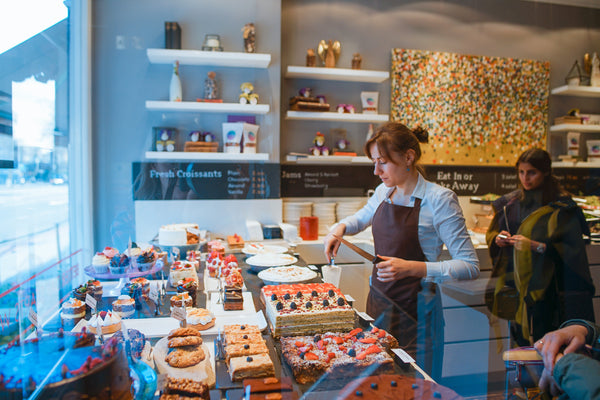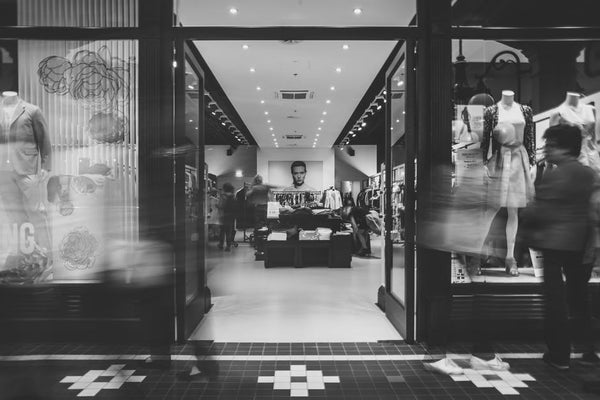Brick-and-mortar stores versus ecommerce — it’s no longer a choice between one or the other. Multichannel sales are here to stay as savvy shoppers engage with brands through multiple touch points, whether it’s in-store, online, through social media, or elsewhere.
While ecommerce stores and sales are growing exponentially, 94% of total retail sales are still generated in physical stores. So, for those merchants waiting to take the leap into in-person sales, there’s no better time than the present.
Are you hesitant to take the next step from selling your products behind a screen to venturing into in-person sales? It can feel overwhelming to make the jump from exclusively selling online to adding face-to-face customer interactions, but there are definite benefits to your business that come with this growth.
While the ecommerce industry currently has $294 billion in sales (projected to be $414 billion by 2018), retail sales make up $3.9 trillion in sales across the 1.1 million retail establishments in the U.S. alone — according to the Retail TouchPoints article Retail Vs. E-Commerce Trends: A Match Made In Heaven.
Of course, selling online involves less risk than opening a brick-and-mortar store, staffing the store, and getting the inventory in the store to open it — but let’s take a look at how you can do it with less fuss while enjoying just as many of the rewards.
Pop-up Shops
Temporary retail, also known as pop-up shops, is a great way to test the waters of in-person sales for your ecommerce business. Set up a shop for a weekend, a full week, or even a month in the neighborhood of your choosing — and get to know your audience, see if that location is the right place for you, and see how much product you can actually sell at a retail location.
If you aren’t interested (or ready) to open a full-time brick-and-mortar location, pop-up shops are also the perfect way to move excess product, host large door-crasher sales, and hold short-term promotions from time to time. This way, you get all the benefits of selling for certain periods of time without having to open a year-round retail location.
More reading on running your own pop-up shop:
Brand Awareness
 One of the most difficult aspects of ecommerce sales can be visibility. Making your target customers aware of what you’re selling and how you’re different from competitors is a major challenge for brands.
One of the most difficult aspects of ecommerce sales can be visibility. Making your target customers aware of what you’re selling and how you’re different from competitors is a major challenge for brands.
But bringing your products and your brand to a retail location offers the opportunity for more people to become familiar with your brand and its offerings.
As the article Online vs Offline Retail: Pros, Cons & an Omni-Channel Future explains: “Having an offline store also gives you instant access to passing trade, without having to invest in a marketing budget. Having a great store location can make you easily visible to your target market and can build your brand locally.”
While it’s helpful to have a physical presence for passersby to get to know your brand, retail locations also allow you to move product around, test displays, and invite your customers to interact with your brand in a different way than they do online.
“With a traditional bricks-and-mortar store, you can craft a unique experience for your customers and express your brand in a creative way,” says Statement Agency about multichannel retail.
Customer Experience
When it comes to providing your customers with an immersive brand experience, online stores just can’t touch physical retail. Not only can merchants set up their products and displays in a way that reflects their brand identity, but storefronts allow your customers to interact with your products in a new way.
In the RetailDive article Why most shoppers still choose brick-and-mortar stores over e-commerce, they found that “the ability to see, touch and feel products as well as take items home immediately rank highest among the reasons consumers choose to shop in stores versus online.”
Offering your customers the opportunity to see, touch, and feel your products is especially beneficial if you have a complex product that would otherwise require a lot of explanation and marketing resources to explain in a digital medium. It’s easier to provide product demos in person, as well as offer tailored product solutions to fit their specific needs.
Not sure how to tackle an immersive retail experience? Take a look at a few examples, or read up on some immersive retail design strategies.
Upselling Potential
 Shoppers often travel into stores for the instant gratification that comes with buying an item and bringing it home immediately. RetailDive found that “shoppers also want it now and want it fast. 49% of consumers say they choose stores over the web because they want “to take items home immediately.”
Shoppers often travel into stores for the instant gratification that comes with buying an item and bringing it home immediately. RetailDive found that “shoppers also want it now and want it fast. 49% of consumers say they choose stores over the web because they want “to take items home immediately.”
This suggests that next-day — let alone two-day — shipping cannot fully replicate the immediate gratification of buying products in store and taking them home.
These shoppers who make quick purchases are perfect candidates to pick up additional items on impulse while they’re in the store. Not sure how to nail the upsell? Read up on some strategies in our article The Art of Retail Upselling : How to Get Your Customers to Buy More (+ Tools and Examples) or learn how to use techniques like suggestive selling.
Get to Know Your Customers
There are many ways to gather intel about your customers online through ecommerce analytics, but there’s something special about meeting your customers face-to-face and having a real conversation with them. In-person sales, whether in a stationary retail location or pop-up shop, are a great opportunity to see how your customers interact with your products.
You can send out surveys to your ecommerce customers and hope that they respond, but when you’re in store, there’s a chance to naturally spark up a conversation with them about what they liked or didn’t like about the merchandise. This information is invaluable in improving your product offerings, developments, and brand.
Reach New Customers
In the article Retail Vs. E-Commerce Trends: A Match Made In Heaven, Retail TouchPoints states that while foot traffic is on the decline, certain demographics tend to prefer the brick-and-mortar shopping experience over the ecommerce one — specifically seniors and teens.
By offering your merchandise in a physical retail setting, you could reach new customers that otherwise wouldn’t find your brand online, since that’s not where they’re spending their money. And even if these potential customers are aware of your online store, they might not be willing to spend their money there because “72% of young customers research their options online before actually making it to the store” and 75% of those who find online info helpful are more likely to make the trek and visit a store.
Minimal Shipping Costs
 In addition to all the aforementioned reasons, creating in-person sales opportunities can help your customers (and your business) save on costs. That’s because in-person sales don’t necessarily require shipping and handling costs for you or your customers.
In addition to all the aforementioned reasons, creating in-person sales opportunities can help your customers (and your business) save on costs. That’s because in-person sales don’t necessarily require shipping and handling costs for you or your customers.
While this may seem like a small drop in the bucket (and for some businesses, it is), if you sell any oversized, irregular items, or specialty items that cost extra packaging and shipping then in-store sales could save you some serious coin in the long term.
Moving Forward With In-Person Sales
Are you an ecommerce brand that dabbles in face-to-face sales from time to time or do you operate a full-time brick-and-mortar location? If so, tell us what you think about the benefits of in-person sales.
Read more
- Why the Top Ecommerce Brands Are Moving Into Physical Retail (And What You Can Learn From Them)
- Making the Leap to Retail: Why These Online Brands are Investing in In-Person Sales
- 3 Questions Every Merchant Needs to Ask Themselves When Planning a Pop-Up
- Craft Fairs and Art Shows 101: Sell Products In-Person
- Small Storefront, Big Impact: Distinguish Your Brand with a Pop-Up Store at Expos
- Deals on Wheels: Why More Retailers Are Taking to the Streets
- Retailers, Here's Why Having a Brick-and-Mortar Store is a Competitive Advantage
- 15 Tips to Help Retailers Snag Startup Funding





